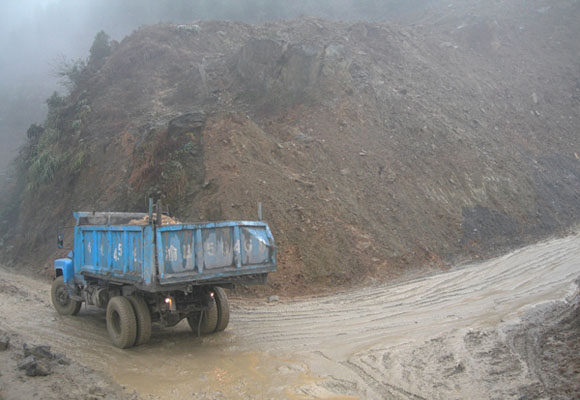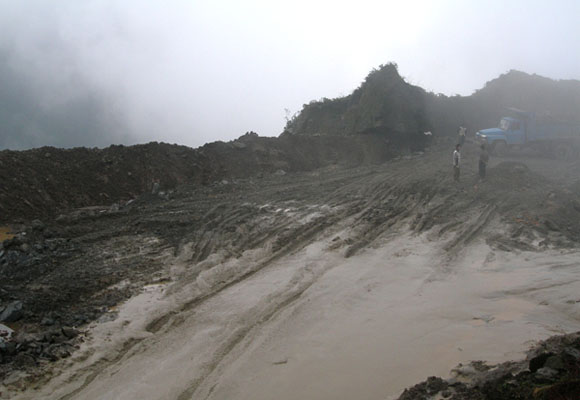
Vertebrates (pdf)
Baseline study at Mabian Dafengding Nature Reserve, Sichuan (pdf)
by Fion Cheung
With sponsorship provided by the Ocean Park Conservation Fund Hong Kong (OPCFHK), Tony Hung (ENS Year 2) and I had the chance to join a group of researchers and postgraduate students from Sichuan University to conduct a baseline study at Mabian Dafengding Nature Reserve, Southern Sichuan from 4 to 14 December, 2005. Since Tony and I are interested in bird watching, we followed an ornithologist, Mr. Zheng Zhirong, to conduct the bird survey while other surveyors conducted plant and mammal surveys. In our 4-day survey, we spent about 8 hours a day doing transect counts along planned routes in different areas including climbing up hills to reach pristine places in the nature reserve. Any bird species observed were recorded together with the time and location by using a Global Positioning System Unit. A total of 27 bird species (Table 1) was recorded. These included two protected species of Sichuan Province, the Greater Yellownape (Picus flavinucha) and the Red-headed Trogon (Harpactes erythrocephalus); both were also new records in Dafengding Nature Reserve. For me, every bird species we came across was really amazing because most of them (21 species) were my first records! Through conversations with Mr. Zheng, I also learned about the interesting distribution patterns of birds and methods for distinguishing bird species with similar appearance.
During this trip, we learned that the building of hydropower stations (Fig. 1) and mining operations (Fig. 2) are two of the main threats (in addtion to illegal collection of bamboo shoots, logging and hunting) that the nature reserve is now facing. The former inevitably destroys natural streams and the electricity generated does not even benefit the local communities. Mining explosions were heard almost non-stop throughout the days during our survey which was on top of a 2000 m mountain. The scenes of birds flushed by the explosions really made us sad. These mining activities do not just result in serious habitat destruction and soil erosion but also heavy traffic jams in the area as the over-loaded mining trucks often broke down on the narrow nature reserve road. One night when we were on the way back to the city, which is just 40 km away from the nature reserve, we were trapped in the bus for 19 hours because of several traffic congestions!
 |
 |
| Fig. 1. A natural stream (left) and a hydropower station (right) in Shaqiang Nature Reserve Station. | |
Table 1. Bird species recorded in a 4-day survey at Dafengding Nature Reserve. Common and species names follow MacKinnon et al. (2000). A field guide to the birds of China. Oxford University Press, 517pp.
|
No. |
Common name |
Species name |
|
1 |
Black-browed Tit |
Aegithalos bonvaloti |
|
2 |
Black-faced Laughingthrush |
Garrulax affinis |
|
3 |
Blue-fronted Redstart |
Phoenicurus frontalis |
|
4 |
Brown Dipper |
Cinclus pallasii |
|
5 |
Chestnut Thrush |
Turdus rubrocanus |
|
6 |
Chestnut-crowned Laughingthrush |
Garrulax erythrocephalus |
|
7 |
Crimson-breasted Woodpecker |
Dendrocopos cathpharius |
|
8 |
Eurasian Jay |
Garrulus glandarius |
|
9 |
Golden-breasted Fulvetta |
Alcippe chrysotis |
|
10 |
Greater Yellownape |
Picus flavinucha |
|
11 |
Green-backed Tit |
Parus monticolus |
|
12 |
Grey-cheeked Fulvetta |
Alcippe morrisonia |
|
13 |
Grey-headed Bullfinch |
Pyrrhula erythaca |
|
14 |
Grey-headed Woodpecker |
Picus canus |
|
15 |
Little Forktail |
Enicurus scouleri |
|
16 |
Orange-flanked Bush Robin |
Tarsiger cyanurus |
|
17 |
Plumbeous Water Redstart |
Rhyacornis fuliginosus |
|
18 |
Red-billed Blue Magpie |
Urocissa erythrorhyncha |
|
19 |
Red-headed Trogon |
Harpactes erythrocephalus |
|
20 |
Red-winged Laughingthrush |
Garrulax formosus |
|
21 |
Rufous-capped Babbler |
Stachyris ruficeps |
|
22 |
Streak-breasted Scimitar Babbler |
Pomatorhinus ruficollis |
|
23 |
Vinaceous Rosefinch |
Carpodacus vinaceus |
|
24 |
White-capped Water Redstart |
Chaimarrornis leucocephalus |
|
25 |
Winter Wren |
Troglodytes troglodytes |
|
26 |
Yellow-bellied Tit |
Parus venustulus |
|
27 |
Yellow-throated Bunting |
Emberiza elegans |
The conflict between development and environmental protection is very apparent at Dafengding. I think it is critical is to find a balance between them. Development is, of course, needed especially in developing countries but one should also bear in mind that the destroyed environment can probably never revert back to its original state. With more and more people better educated in Mainland China, I sincerely hope that people will be prepared to stand up and ask for better conservation policies such as enforcing environment impact assessments (EIA), especially in provinces with rich biodiversity such as Sichuan and Yunnan.
 |
 |
 |
| Fig. 2. Mining activities causing serious soil erosion. |
I would like to express my sincere gratitude to OPCFHK and DEB for organizing this valuable trip giving us the opportunity to see what is actually happening outside Hong Kong with our own eyes. I still remember the conversation I had with experts in Dafengding. I asked whether they felt frustrated and were pessimistic about the future as their study area was being destroyed even though they had collected data showing its ecological importance. They said, "Yes, of course. But at least we have tried our best to protect this place. Keeping the frustration and doing nothing cannot help the situation. So, no matter how little we can achieve, we will keep on doing our work." I just wish to share this comment with all colleagues in the conservation field.
P.12-13
|
Porcupine! |
 Copyright © 2000 |
